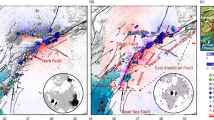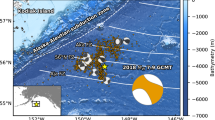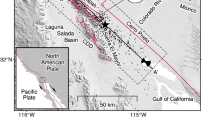Abstract
How fault geometry controls the rupture propagation and segmentation of a strike-slip event is an open question. Deciphering the relationship between the geometric fault complexity and seismic kinematics is essential for both understanding the seismic hazard posed by a particular fault and gaining insights into the fundamental mechanics of earthquake rupture. Here we integrate the finite-fault inversion of synthetic aperture radar observations and back projection of high-frequency teleseismic array waveforms to investigate the rupture geometry of the 2023 Mw 7.8 and Mw 7.6 Kahramanmaraş (southeastern Turkey) earthquake doublet and its impact on the kinematics and slip distribution. We find that large slip asperities are separated by fault bends, whereas intense high-frequency (~1 Hz) sources occur near the branching junctions, suggesting that geometric barriers could decelerate rupture propagation and enhance high-frequency wave radiations. In addition, supershear rupture propagating along the relatively high-velocity material is prone to occur on geometrically simple and smooth faults with relatively few aftershocks. These kinematic characteristics highlight that the geometric complexity of the fault system may be a key factor in the irregular cascading rupture process.
This is a preview of subscription content, access via your institution
Access options
Access Nature and 54 other Nature Portfolio journals
Get Nature+, our best-value online-access subscription
$29.99 / 30 days
cancel any time
Subscribe to this journal
Receive 12 print issues and online access
$259.00 per year
only $21.58 per issue
Buy this article
- Purchase on Springer Link
- Instant access to full article PDF
Prices may be subject to local taxes which are calculated during checkout




Similar content being viewed by others
Data availability
The Sentinel-1 Synthetic Aperture Radar (SAR) data are made available by the European Space Agency and can be accessed at http://scihub.copernicus.eu/dhus. The GNSS raw data are provided by Türkiye Ulusal Sabit GNSS Ağı-Aktif (TUSAGA-Active) System (https://www.tusaga-aktif.gov.tr/Web/DepremVerileri.aspx). All seismograms are available online. The seismic data are provided by the Incorporated Research Institutions for Seismology (IRIS, www.iris.edu) and the Data Management Center of China National Seismic Network at the Institute of Geophysics, China Earthquake Administration (SEISDMC, https://doi.org/10.7914/SN/CB, https://data.earthquake.cn/index.html). The catalogue of relocated aftershocks of the 2023 Turkey earthquake doublet is available at https://github.com/YijianZhou/Seismic-Catalog/blob/main/ding-zhou_eqs-2023_tk-palm_v4.ctlg. The geodetic data, slip models and datasets relevant to BP results can be downloaded from https://doi.org/10.5281/zenodo.8271589. Detailed README files are available, providing summaries of the data and data formats.
Code availability
The open-source GMTSAR software can be accessed at https://github.com/gmtsar/gmtsar. The PRIDE PPP-AR is available at https://github.com/PrideLab/PRIDE-PPPAR. The SDM code can be found at ftp://ftp.gfz-potsdam.de/pub/home/turk/wang/. The MATLAB code of SEBP is available at https://github.com/lsmeng/MUSICBP/tree/SEBP. Figures in this study were generated using GMT59. All other codes used in this study are available upon request.
References
Bruhat, L., Fang, Z. & Dunham, E. M. Rupture complexity and the supershear transition on rough faults. J. Geophys. Res. Solid Earth 121, 210–224 (2016).
Duan, B. & Oglesby, D. D. Multicycle dynamics of nonplanar strike-slip faults. J. Geophys. Res. Solid Earth 110, B03304 (2005).
Kase, Y. & Day, S. M. Spontaneous rupture processes on a bending fault. Geophys. Res. Lett. 33, L10302 (2006).
Fan, W., Shearer, P. M., Ji, C. & Bassett, D. Multiple branching rupture of the 2009 Tonga–Samoa earthquake. J. Geophys. Res. Solid Earth 121, 5809–5827 (2016).
Zhang, L., Liu, Y., Li, D., Yu, H. & He, C. Geometric control on seismic rupture and earthquake sequence along the Yingxiu–Beichuan fault with implications for the 2008 Wenchuan earthquake. J. Geophys. Res. Solid Earth 127, e2022JB024113 (2022).
Manighetti, I. et al. Generic along-strike segmentation of Afar normal faults, East Africa: implications on fault growth and stress heterogeneity on seismogenic fault planes. Geochem. Geophys. Geosyst. 16, 443–467 (2015).
Okuwaki, R. & Yagi, Y. Role of geometric barriers in irregular-rupture evolution during the 2008 Wenchuan earthquake. Geophys. J. Int. 212, 1657–1664 (2018).
Reilinger, R. et al. GPS constraints on continental deformation in the Africa–Arabia–Eurasia continental collision zone and implications for the dynamics of plate interactions. J. Geophys. Res. Solid Earth 111, B05411 (2006).
Taymaz, T., Westaway, R. & Reilinger, R. Active faulting and crustal deformation in the Eastern Mediterranean region. Tectonophysics 391, 1–9 (2004).
Duman, T. Y. & Emre, Ö. The East Anatolian Fault: geometry, segmentation and jog characteristics. Geol. Soc. Lond. Spec. Publ. 372, 495–529 (2013).
Güvercin, S. E., Karabulut, H., Konca, A. Ö., Doğan, U. & Ergintav, S. Active seismotectonics of the East Anatolian Fault. Geophys. J. Int. 230, 50–69 (2022).
Melgar, D. et al. Sub- and super-shear ruptures during the 2023 Mw 7.8 and Mw 7.6 earthquake doublet in SE Türkiye. Seismica https://doi.org/10.26443/seismica.v2i3.387 (2023).
Ambraseys, N. N. Temporary seismic quiescence: SE Turkey. Geophys. J. Int. 96, 311–331 (1989).
Dal Zilio, L. & Ampuero, J.-P. Earthquake doublet in Turkey and Syria. Commun. Earth Environ. 4, 71 (2023).
Emre, Ö. et al. Active fault database of Turkey. Bull. Earthq. Eng. 16, 3229–3275 (2018).
Okuwaki, R., Yagi, Y., Taymaz, T. & Hicks, S. P. Multi-scale rupture growth with alternating directions in a complex fault network during the 2023 south-eastern Türkiye and Syria earthquake doublet. Geophys. Res. Lett. 50, e2023GL103480 (2023).
Shen, Z.-K. et al. Slip maxima at fault junctions and rupturing of barriers during the 2008 Wenchuan earthquake. Nat. Geosci. 2, 718–724 (2009).
Earthquakes (USGS, 2023); https://usgs.gov/programs/earthquake-hazards/earthquakes
Meng, L., Zhang, A. & Yagi, Y. Improving back projection imaging with a novel physics-based aftershock calibration approach: a case study of the 2015 Gorkha earthquake. Geophys. Res. Lett. 43, 628–636 (2016).
Zhang, Y., Bao, H., Aoki, Y. & Hashima, A. Integrated seismic source model of the 2021 M 7.1 Fukushima earthquake. Geophys. J. Int. 233, 93–106 (2023).
Zhang, Y., Bao, H., Meng, L. & Aoki, Y. Understanding and mitigating the spatial bias of earthquake source imaging with regional slowness enhanced back-projection. J. Geophys. Res. Solid Earth 128, e2022JB025525 (2023).
Laske, G., Masters, G., Ma, Z. & Pasyanos, M. E. CRUST1.0: an updated global model of Earth’s crust. Geophys. Res. Abstr. 14, abstr. EGU2012-3743-1 (2012).
Li, B. et al. Rupture heterogeneity and directivity effects in back-projection analysis. J. Geophys. Res. Solid Earth 127, e2021JB022663 (2022).
Guo, R., Zheng, Y. & Xu, J. Stress modulation of the seismic gap between the 2008 Ms 8.0 Wenchuan earthquake and the 2013 Ms 7.0 Lushan earthquake and implications for seismic hazard. Geophys. J. Int. 221, 2113–2125 (2020).
Elliott, A. J., Dolan, J. F. & Oglesby, D. D. Evidence from coseismic slip gradients for dynamic control on rupture propagation and arrest through stepovers. J. Geophys. Res. Solid Earth 114, B02312 (2009).
Klinger, Y., Michel, R. & King, G. C. P. Evidence for an earthquake barrier model from Mw ~7.8 Kokoxili (Tibet) earthquake slip-distribution. Earth Planet. Sci. Lett. 242, 354–364 (2006).
Liang, Z., Wei, Z., Sun, W. & Zhuang, Q. Surface slip distribution and earthquake rupture model of the Fuyun Fault, China, based on high-resolution topographic data. Lithosphere 2021, 7913554 (2021).
Madariaga, R. High-frequency radiation from crack (stress drop) models of earthquake faulting. Geophys. J. R. Astron. Soc. 51, 625–651 (1977).
Yamashita, T. High-frequency acceleration radiated by unsteadily propagating cracks and its near-source geometrical attenuation. J. Phys. Earth 31, 1–32 (1983).
Tang, R., Yuan, J. & Gan, L. Free-surface-induced supershear transition in 3-D simulations of spontaneous dynamic rupture on oblique faults. Geophys. Res. Lett. 48, e2020GL091621 (2021).
Rousseau, C.-E. & Rosakis, A. J. Dynamic path selection along branched faults: experiments involving sub-Rayleigh and supershear ruptures. J. Geophys. Res. Solid Earth 114, B08303 (2009).
Templeton, E. L. et al. Finite element simulations of dynamic shear rupture experiments and dynamic path selection along kinked and branched faults. J. Geophys. Res. Solid Earth 114, B08304 (2009).
Bouchon, M. et al. Faulting characteristics of supershear earthquakes. Tectonophysics 493, 244–253 (2010).
Perrin, C., Manighetti, I., Ampuero, J.-P., Cappa, F. & Gaudemer, Y. Location of largest earthquake slip and fast rupture controlled by along-strike change in fault structural maturity due to fault growth. J. Geophys. Res. Solid Earth 121, 3666–3685 (2016).
Manighetti, I., Mercier, A. & De Barros, L. Fault trace corrugation and segmentation as a measure of fault structural maturity. Geophys. Res. Lett. 48, e2021GL095372 (2021).
Qiao, X., Zhou, Y. & Zhang, P. Along-strike variation in fault structural maturity and seismic moment deficits on the Yushu–Ganzi–Xianshuihe fault system revealed by strain accumulation and regional seismicity. Earth Planet. Sci. Lett. 596, 117799 (2022).
Westaway, R. O. B. & Arger, J. A. N. The Gölbaşı basin, southeastern Turkey: a complex discontinuity in a major strike-slip fault zone. J. Geol. Soc. 153, 729–744 (1996).
Tan, O. A homogeneous earthquake catalogue for Turkey. Nat. Hazards Earth Syst. Sci. 21, 2059–2073 (2021).
Balkaya, M., Akyüz, H. S. & Özden, S. Paleoseismology of the Sürgü and Çardak faults—splays of the Eastern Anatolian Fault Zone, Türkiye. Turk. J. Earth Sci. 32, 402–420 (2023).
Goebel, T. H. W., Brodsky, E. E. & Dresen, G. Fault roughness promotes earthquake-like aftershock clustering in the lab. Geophys. Res. Lett. 50, e2022GL101241 (2023).
Ding, H. et al. High-resolution seismicity imaging and early aftershock migration of the 2023 Kahramanmaraş (SE Türkiye) Mw 7.9 & 7.8 earthquake doublet. Earthq. Sci. https://www.equsci.org.cn/en/article/doi/10.1016/j.eqs.2023.06.002 (2023).
Bouchon, M. & Karabulut, H. The aftershock signature of supershear earthquakes. Science 320, 1323–1325 (2008).
Bao, H. et al. Global frequency of oceanic and continental supershear earthquakes. Nat. Geosci. 15, 942–949 (2022).
Langer, S., Olsen-Kettle, L. & Weatherley, D. Identification of supershear transition mechanisms due to material contrast at bimaterial faults. Geophys. J. Int. 190, 1169–1180 (2012).
Shlomai, H. & Fineberg, J. The structure of slip-pulses and supershear ruptures driving slip in bimaterial friction. Nat. Commun. 7, 11787 (2016).
Wang, H. et al. Isotropic and anisotropic P wave velocity structures of the crust and uppermost mantle beneath Turkey. J. Geophys. Res. Solid Earth 125, e2020JB019566 (2020).
Bayrak, E., Yılmaz, Ş., Softa, M., Türker, T. & Bayrak, Y. Earthquake hazard analysis for East Anatolian Fault Zone, Turkey. Nat. Hazard. 76, 1063–1077 (2015).
Lomax, A. Precise, NLL-SSST-coherence hypocenter catalog for the 2023 Mw 7.8 and Mw 7.6 SE Turkey earthquake sequence data sets. Zenodo https://doi.org/10.5281/zenodo.7699882 (2023).
Sandwell, D., Mellors, R., Tong, X., Wei, M. & Wessel, P. Open radar interferometry software for mapping surface deformation. Eos 92, 234–234 (2011).
Goldstein, R. M. & Werner, C. L. Radar interferogram filtering for geophysical applications. Geophys. Res. Lett. 25, 4035–4038 (1998).
Chen, C. W. & Zebker, H. A. Two-dimensional phase unwrapping with use of statistical models for cost functions in nonlinear optimization. J. Opt. Soc. Am. A 18, 338 (2001).
Geng, J. et al. PRIDE PPP-AR: an open-source software for GPS PPP ambiguity resolution. GPS Solut. 23, 91 (2019).
Jónsson, S. N., Zebker, H., Segall, P. & Amelung, F. Fault slip distribution of the 1999 Mw 7.1 Hector Mine, California, Earthquake, estimated from satellite radar and GPS measurements. Bull. Seismol. Soc. Am. 92, 1377–1389 (2002).
Wang, R. et al. The 2011 Mw 9.0 Tohoku earthquake: comparison of GPS and strong-motion data. Bull. Seismol. Soc. Am. 103, 1336–1347 (2013).
Okada, Y. Surface deformation due to shear and tensile faults in a half-space. Bull. Seismol. Soc. Am. 75, 1135–1154 (1985).
Bao, H. et al. Early and persistent supershear rupture of the 2018 magnitude 7.5 Palu earthquake. Nat. Geosci. 12, 200–205 (2019).
Meng, L. et al. Double pincer movement: encircling rupture splitting during the 2015 Mw 8.3 Illapel earthquake. Earth Planet. Sci. Lett. 495, 164–173 (2018).
Meng, L., Huang, H., Xie, Y., Bao, H. & Dominguez, L. A. Nucleation and kinematic rupture of the 2017 Mw 8.2 Tehuantepec earthquake. Geophys. Res. Lett. 46, 3745–3754 (2019).
Wessel, P. et al. The Generic Mapping Tools version 6. Geochem. Geophys. Geosyst. 20, 5556–5564 (2019).
Acknowledgements
H.S. was supported by the Strategic Priority Research Program of the Chinese Academy of Sciences (XDB 41000000). R.G. and X.T. were supported by the State Key Laboratory of Geodesy and Earth’s Dynamics (S22L620104). Y. Zhang, R.G., X.T. and J.W. were supported by the Open Fund of Wuhan Gravitation and Solid Earth Tides National Observation and Research Station (WHYWZ202210). Y. Zheng and D.L. were supported by the NSFC grants (42274082, 42030108). The teleseismic waveforms of the China array are provided by the Data Management Center of China National Seismic Network at the Institute of Geophysics, China Earthquake Administration. T.T. and T.E. acknowledge the Istanbul Technical University Research Fund (ITU-BAP) and the Alexander von Humboldt Foundation Research Fellowship Award for providing computing facilities through the Humboldt-Stiftung Follow-Up Program.
Author information
Authors and Affiliations
Contributions
R.G. conceived and led the study. Y. Zhang and D.L. performed the uniform SEBP and regional SEBP. X.T. performed the InSAR analysis and finite-fault inversion. Y. Zhang, X.T., D.L., R.G., T.T., T.E., Y. Zheng, J.W. and H.S. wrote the paper and participated in the interpretation of the results.
Corresponding author
Ethics declarations
Competing interests
The authors declare no competing interests.
Peer review
Peer review information
Nature Geoscience thanks Lei Zhang and the other, anonymous, reviewer(s) for their contribution to the peer review of this work. Primary Handling Editor: Tamara Goldin, in collaboration with the Nature Geoscience team.
Additional information
Publisher’s note Springer Nature remains neutral with regard to jurisdictional claims in published maps and institutional affiliations.
Extended data
Extended Data Fig. 1 Mapping fault traces.
Sentinel-1 wrapped interferograms of the descending (a) and ascending (d) tracks. Unwrapped deformation of the descending (b) and ascending (e) tracks. Range pixel offset results of the 2023 Kahramanmaraş earthquake doublet along the descending (c) and ascending (f) tracks. Red and blue colors mean that the displacements move toward and away from the satellite, respectively. The black lines represent the mapped traces of the seismogenic faults. The red and green stars are the epicenters of the Mw 7.8 earthquake and the Mw 7.6 earthquake, respectively.
Extended Data Fig. 2 Estimation of the potential impact of postseismic deformation.
GNSS time series of ANTE (a) and EKZ1 (b) sites. LOS postseismic deformation along the ascending (c) and descending (d) track. Yellow triangles show the locations of ANTE and EKZ1, respectively. The beachball indicates the focal mechanism of the Mw 6.3 aftershock on February 20, 2023 (USGS). Other symbols are the same as Extended Data Fig. 1.
Extended Data Fig. 3 Search results of our preferred model.
(a) The trade-off between the data misfit and model roughness. (b) The search for dip of the Mw 7.6 earthquake. The red circle indicates the optimal dip of 76°.
Extended Data Fig. 4 InSAR fittings.
Observations of the ascending (a) and descending (d) orbits. Predictions along ascending (b) and descending (e) tracks. (c) and (f) Associated residuals.
Extended Data Fig. 5 Checkerboard test results.
(a) The input of slip distribution. (b) The recovered slip distribution using the same inversion strategies.
Extended Data Fig. 6 Station distribution.
Telesesimic arrays for back-projection analysis of the 2023 Mw 7.8 (a) and Mw 7.6 (b) Kahramanmaraş earthquake doublet. The colored triangles represent the seismic stations from arrays in Alaska (AK) and China (CN). The red and green stars denote the locations of the Mw 7.8 and Mw 7.6 earthquakes in the 2023 Kahramanmaraş earthquake doublet.
Extended Data Fig. 7 Spatial bias of BPs.
Spatial biases of the Mw 7.8 earthquake for the AK array, before (a) and after (b) the regional SEBP calibration.
Extended Data Fig. 8 Background seismicity.
Seismic activity in southeastern Türkiye during 1900–2018 from ref. 38. (a) Distribution of background seismicity and the 2023 Kahramanmaraş earthquake doublet. The red and green stars indicate the locations of the epicenters of the Mw 7.8 and Mw 7.6 earthquakes. The red dots indicate earthquakes of small magnitude (1 < M < 5.5) while yellow stars indicate earthquakes of larger magnitude (5.5 < M < 8.0). The black lines indicate the mapped fault traces. The green lines represent the depth profiles of earthquakes. (b) Cross-section of the earthquake locations for profiles AB and BC. (c) Cross-section of the earthquake locations for profile DE.
Extended Data Fig. 9 Lateral variation of the isotropic Vp images resolved at three depth layers.
At the central top of each map, the layer depth is given: (a) 4, (b) 12, and (c) 21 km. Relatively high and low Vp perturbations from ref. 46 are represented by the blue and red colors, respectively. The red and green stars indicate the locations of the epicenters of the Mw 7.8 and Mw 7.6 events. The black lines indicate the mapped fault traces.
Supplementary information
Supplementary Information
Supplementary Tables 1–5.
Supplementary Video 1
BP movie for the Mw 7.8 earthquake.
Supplementary Video 2
BP movie for the Mw 7.6 earthquake.
Rights and permissions
Springer Nature or its licensor (e.g. a society or other partner) holds exclusive rights to this article under a publishing agreement with the author(s) or other rightsholder(s); author self-archiving of the accepted manuscript version of this article is solely governed by the terms of such publishing agreement and applicable law.
About this article
Cite this article
Zhang, Y., Tang, X., Liu, D. et al. Geometric controls on cascading rupture of the 2023 Kahramanmaraş earthquake doublet. Nat. Geosci. 16, 1054–1060 (2023). https://doi.org/10.1038/s41561-023-01283-3
Received:
Accepted:
Published:
Issue Date:
DOI: https://doi.org/10.1038/s41561-023-01283-3



